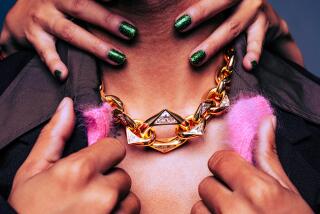Oh, So Cultured
- Share via
There’s more to stringing pearls than just pulling thread through holes. Most pearls, including the best imitations, have knots between them.
“The knots,” says Magdalena Berg Osherenko. It’s all in the knots. They keep the pearls from scratching each other. And, just as important, “if the strand breaks, you lose only one pearl.”
Magdalena, who uses her first name professionally, has been stringing pearls professionally for more than 20 years. Her mother, Melanie Berg, was a pearl stringer too. She started her Beverly Hills business, Melanie Berg & Co., in 1967. Berg’s father, Felix, was also in the jewelry business. Magdalena didn’t plan to follow in her parent’s footsteps. She worked as a Los Angeles Unified first-grade teacher for nine years. But in the mid ‘70s, her father became ill and her mother needed help.
*
In 1981, Magdalena left teaching to take over her mother’s business, on the second floor of an unremarkable Wilshire Boulevard building. Customers walk into a tiny anteroom, knock on a second door, and wait as Magdalena peers through a slim window. They are greeted by a better-than-average dry cleaner display of glossy head shots signed by grateful customers. Some are addressed to Magdalena, some to her mother. There’s Ed McMahon, Judith Krantz, Jacqueline Bisset, Helen Reddy, Don Rickles, and a host of others.
In keeping with the recommendation of the Cultured Pearl Assn., Magdalena tells people to have their pearls restrung once a year. It’s relatively simple to determine whether restringing is due.
Magdalena, who charges according to the number of pearls, their size and strand length (a standard preppy choker, akin to Jacqueline Kennedy’s wedding day set, costs about $100 to restring), tells uncertain callers to put the pearls on a white surface, “like a towel, and take a look at the color of the knots. If the thread looks yellowish or grayish,” then it’s time. A strand also needs attention, says Magdalena, when there’s play between the pearls or the thread is thinning or frayed.
Before Magdalena begins a restringing job, she washes the pearls in water with a mild liquid soap from Europe (she refuses to name the brand) and gently brushes them.
While people might be tempted to clean their pearls themselves, Magdalena warns against doing anything beyond wiping them with a soft cloth. Water doesn’t hurt the pearls, but it ruins the thread. For this reason, Magdalena counsels clients not to shower in their pearls. “The thread is like a towel,” she says. “It absorbs everything.”
Nor is it advisable to swim in that chlorinated pool, says Peter Shemonsky, director of Fine Jewelry and Time Pieces for Butterfields California. He knows one person who “turned a $65,000 strand into a $4,000 strand” by taking a dip. “A pearl,” Shemonsky says, “is an organic material.” But the popular idea that pearls are living and need to breathe, he says, is “a crock. It’s not like you’ve got a pet snake around your neck.”
*
Pearls are susceptible to all kinds of damage, though. The most common, says Shemonsky, is inflicted by the alcohol in perfume, which will eat right through a pearl’s surface. Hair spray is bad for pearls, and direct sunlight, he says, will cause them to “crack and blister.”
“Once the luster is gone,” says Magdalena, “it really can’t be restored. There are people who peel pearls [professionally], but that’s a rare thing.” And risky. Besides, she says, “it’s a monster job. There’s no one in L.A.”
After Magdalena cleans the pearls, she cuts them off the thread, putting them on a dark velvet tray. Then she restrings them with new silk thread, putting a knot between each one.
While Magdalena admits the work is “tedious--every knot is supposed to look like the other ones,” she says--”it can be therapeutic.” But stringing pearls is not like knitting an afghan. “You really need to look,” she says, adding, “I use very strong magnifying glasses.”
*
Many of Magdalena’s clients come to her to update their pearls, perhaps have a long strand turned into a sexy choker. But fashionistas may want to hold off on this surgery. Mikimoto’s Lane says opera length pearls--30-plus inches long--are coming back. “They drop down to the navel,” he says. And a new Mikimoto ad campaign shows “high fashion” 72-inch strands. Adrienne Lee, a sales executive at Van Cleef & Arpels on Rodeo Drive, says a stylist friend reports the latest warm weather trend in Europe is long strands with bathing suits. The pearls, she said, are worn diagonally over the shoulder, like a purse. But, she says, the “short and tight chokers” are still in. “It’s very chic to have one strand of big pearls, like Wilma Flintstone, that kind of big.” These giant pearls, known as South Sea pearls, generally range between 12 and 17 millimeters in diameter and, if excellent quality, can easily cost upwards of $100,000 a strand.
Magdalena, who works for some major jewelers such as Harry Winston and Tallarico Designs, has seen her share of big-ticket pearls. But one job stands out in her memory. “I did pearls that belonged to Marilyn Monroe,” she says, “the ones DiMaggio gave to Marilyn on their honeymoon. I restrung them while they were in the possession of Susan Strasberg. That gave me a thrill.”






